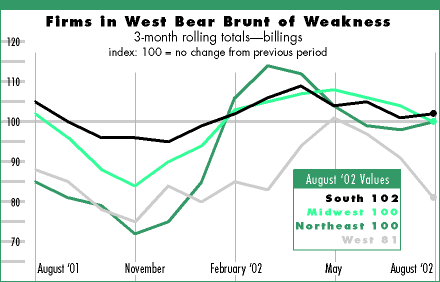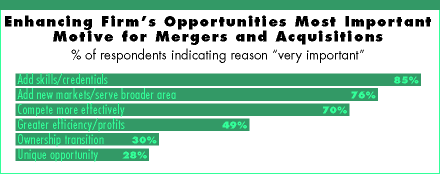
In spite of economic concerns, merger and acquisition activity strong at firms

Work-on-the-Boards Survey
by Kermit Baker, PhD, Hon. AIA
AIA Chief Economist
Billings at U.S. architecture firms declined slightly in August, as for the second straight month a soft spot in the economy slowed construction activity. Billings nationally had grown continuously through the March–June period. In spite of a slowdown, prospects of a rebound in billings at firms remain favorable because inquiries for new projects have not weakened in recent months. With growth in new projects continuing, billings will reverse and resume their growth.
 Firms
in the Northeast, Midwest, and South are reporting stable business levels.
Firms in the West, however, have reported weaker conditions in recent
months. Billings have declined for three months running for firms in this
region, with each drop larger than the previous. In contrast to national
business conditions at firms, which should see resumed growth in the near
future, firms in the West seem poised for a few more months of easing.
Firms
in the Northeast, Midwest, and South are reporting stable business levels.
Firms in the West, however, have reported weaker conditions in recent
months. Billings have declined for three months running for firms in this
region, with each drop larger than the previous. In contrast to national
business conditions at firms, which should see resumed growth in the near
future, firms in the West seem poised for a few more months of easing.
The recent slowdown in billings at architecture firms reflects the overall sluggishness in the economy. Leading indicators of economic activity declined in July and August, pointing to weakness in the months ahead. Even though national business payrolls have increased each of the past four months, the gains have been very modest. Consumer sentiment readings—probably reflecting the poor performance of the stock market—were down in June, July, and August, according to the University of Michigan survey.

The nonresidential construction sector is faring no better, according to information from F.W. Dodge. Nonresidential construction contracts were off 10% in July compared to June figures, and down 11% for the first seven months of the year compared to the same period in 2001. The commercial/industrial sector continues to be the weakest, although emerging budget problems at state and local governments could spell trouble for the institutional sector.
Firms active in mergers
and acquisitions
In spite of an uncertain economic outlook, architecture firms remain engaged
in merger and acquisition activity. Fully 20% of firms in our Work-on-the-Boards
panel indicated that their firm had either engaged in a merger or acquisition
over the past two years, or had actively considered doing so. An additional
12% of firms indicated that they had been actively involved in a related
activity, such as opening a new office or developing a strategic partnership
with another firm. Firms with a mixed practice (no major building represents
50% or more of firm billings) have been more involved in merger and acquisition
activity than other firms.

When asked about the reasons for getting involved in merger and acquisition activity, firms gave answers centered on enhancing their effectiveness in the marketplace. "Adding additional skills/credentials to our firm" was rated as a very important reason for 85% of firms active in these undertakings. Over three-quarters of firms rated "ability to serve new markets/serve a broader area" as very important, while 70% responded similarly for "allow firm to operate more efficiently/profitably". Less important reasons for getting involved in mergers and acquisitions were: "allow owners to sell firm/realize benefits from investment" (30% rated this very important); and "a unique opportunity presented itself" (28%).
Copyright 2002 The American Institute of Architects. All rights reserved.
![]()
|
This month, Work-on-the-Boards-survey participants are saying: Billings were off in August because of staff vacations, not lack
of work. Billings will be up in September. Requests for proposals and business development in general have
slackened substantially in the last several months. The business
environment remains soft. It is becoming harder and harder to identify individuals in the
next generation of architects who are interested in taking on the
extra commitment of becoming owners and leaders of the firm. |
|